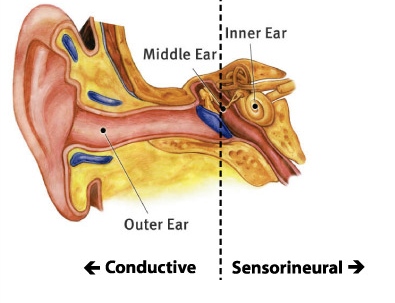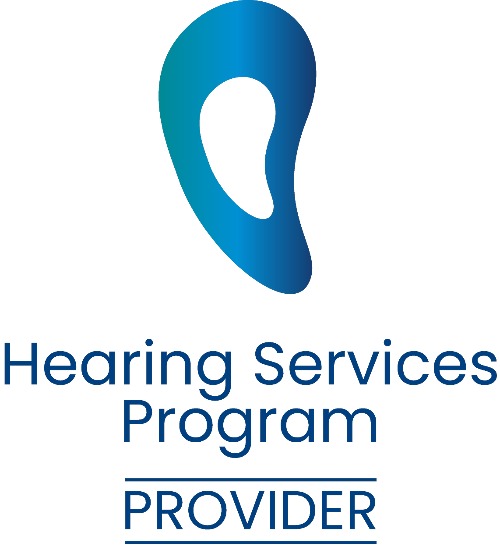Types of Hearing Loss
Hearing loss is prevalent in Australia
One in six Australians is affected by hearing loss, and with an ageing population, this is expected to increase to one in four by 2050.
Hearing loss rivals depression as the most chronic health condition in Australia.
The most common causes of hearing loss are ageing and excessive exposure to loud sounds. The effects of age and noise exposure are additive so that noise exposure may cause hearing loss in middle age that would not otherwise occur until old age.
Three Types of Hearing Loss
- Conductive hearing loss - hearing loss caused by problems with the ear canal, ear drum, or middle ear and its little bones (the malleus, incus, and stapes).
- Sensorineural hearing loss (SNHL) - hearing loss is due to problems of the inner ear, also known as nerve-related hearing loss.
- Mixed hearing loss - refers to a combination of conductive and sensorineural hearing loss. This means that there may be damage in the outer or middle ear and in the inner ear (cochlea) or auditory nerve.

Conductive Hearing Loss
Conductive hearing loss is caused by physical problems with the ear canal, ear drum, or middle ear and its little bones.
Causes
- Malformation of outer ear, ear canal, or middle ear structures
- Fluid in the middle ear from colds
- Ear infection (otitis media - an infection of the middle ear in which an accumulation of fluid may interfere with the movement of the eardrum and ossicles
- Allergies
- Poor Eustachian tube function
- Perforated eardrum
- Benign tumors
- Impacted earwax
- Infection in the ear canal
- Foreign body in the ear
- Otosclerosis
Treatments of Conductive Hearing Loss
Types of conductive hearing loss include congenital absence of ear canal or failure of the ear canal to be open at birth, congenital absence, malformation, or dysfunction of the middle ear structures, all of which may possibly be surgically corrected. If these are not amenable to successful surgical correction, then the hearing alternatively may be improved with amplification with a bone conduction hearing aid, or a surgically implanted, osseointegrated device (for example, the Baha or Ponto System), or a conventional hearing aid, depending on the status of the hearing nerve.
Other causes of conductive hearing loss are: infection; tumors; middle ear fluid from infection or Eustachian tube dysfunction; foreign body; and trauma (as in a skull fracture). Acute infections are usually treated with antibiotic or antifungal medications. Chronic ear infections, chronic middle fluid, and tumors usually require surgery. If there is no response to initial medical therapy, infectious middle ear fluid is usually treated with antibiotics - while chronic non-infectious middle ear fluid is treated with surgery (or pressure equalizing tubes).
Conductive hearing loss from head trauma is frequently amenable to surgical repair of the damaged middle ear structures, performed after the patient’s general medical status is stabilized following acute traumatic injuries.
A genetic form of conductive hearing loss is otosclerosis, in which there is bony fixation of the stapes (the third little bone of hearing in the middle ear), where sound can’t get to the middle ear.
Sensorineural Hearing Loss
Causes
- Ageing (presbycusis)
- Exposure to loud noise
- Head trauma
- Virus or disease
- Autoimmune inner ear disease
- Hearing loss that runs in the family
- Malformation of the inner ear
- Meniere’s Disease
- Otosclerosis - a hereditary disorder in which a bony growth forms around a small bone in the middle ear, preventing it from vibrating when stimulated by sound
- Tumours
Treatment of Sensorineural Hearing Loss
- Sensorineural hearing loss can result from acoustic trauma (or exposure to excessively loud noise), which may respond to medical therapy with corticosteroids to reduce cochlea hair cell swelling and inflammation to improve healing of these injured inner ear structures.
- Sensorineural hearing loss can occur from head trauma or abrupt changes in air pressure such as in airplane descent, which can cause inner ear fluid compartment rupture or leakage, which can be toxic to the inner ear. There has been variable success with emergency surgery when this happens. Sudden sensorineural hearing loss, presumed to be of viral origin, is an otologic emergency that is medically treated with corticosteroids.
- Bilateral progressive hearing loss over several months, also diagnosed as autoimmune inner ear disease, is managed medically with long-term corticosteroids and sometimes with drug therapy. Autoimmune inner ear disease is when the body’s immune system misdirects its defenses against the inner ear structures to cause damage in this part of the body.
- Fluctuating sensorineural hearing loss may be from unknown cause or associated with Meniere’s Disease. Symptoms of Meniere’s disease are hearing loss, tinnitus (or ringing in the ears), and vertigo. Meniere’s disease may be treated medically with a low-sodium diet, diuretics, and corticosteroids. If the vertigo is not medically controlled, then various surgical procedures can be used to eliminate the vertigo.
- Sensorineural hearing loss from tumors of the balance nerve adjacent to the hearing nerve, generally are not reversed with surgical removal or irradiation of these benign tumors. If the hearing loss is mild and the tumors are very small, hearing may be saved in 50 percent of those undergoing hearing preservation surgery for tumor removal.
- Sensorineural hearing loss from disease in the central nervous system may respond to medical management for the specific disease affecting the nervous system. For example, hearing loss secondary to multiple sclerosis may be reversed with treatment for multiple sclerosis.
- Irreversible sensorineural hearing loss, the most common form of hearing loss, may be managed with hearing aids. When hearing aids are not enough, this type of hearing loss can be surgically treated with cochlear implants.
























